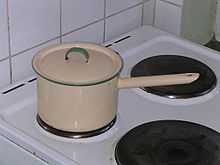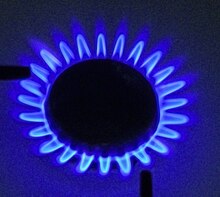Cooktop

Acooktop(American English),stovetop(Canadian and American English) orhob(British English), is a device commonly used forcookingthat is commonly found in kitchens and used to apply heat to the base ofpans or pots.Cooktops are often found integrated with anoveninto akitchen stovebut may also be standalone devices. Cooktops are commonly powered by gas or electricity, although oil or other fuels are sometimes used.
Gas
[edit]
Gas cooktops consist of one or moregas burnerswith arrangements to control the rate of flow. They often have integral lighters or (in older models)pilot lights,[1]and may have safety interlocks designed to reduce the risk of hazardous gas leaks.[2]
Gas cooking has been associated with negative health effects, such as reduced pulmonary function[3]and a higher rate of respiratory symptoms in children.[4]
Electric
[edit]
Coil
[edit]Anelectric coil cooktopuses electric heating elements, beneath a surface ofcast iron,that directly heats pots placed on them. They are inexpensive to buy and maintain, but are considered more difficult to clean than smooth-top models.[5][6][7]
Plate
[edit]Anelectric plate cooktopis similar to a coil cooktop but uses plate-like base supports as opposed to coil supports.
Ceramic radiation heating
[edit]
Aceramic radiation heating cooktophas a surface made of low-expansion thermalglass-ceramicthat is transparent to infrared.[5]This surface houses radiant orhalogen heatersbelow it. The advantage of this arrangement is that the heat can be quickly controlled. These cooktops are often simply calledceramic cooktoporceramic-glass cooktop,because they were the first type of cooktop to use glass-ceramic—however, other types of cooktops also use glass-ceramic surfaces, notably induction cooktops.
Induction
[edit]
Aninduction cooktopinvolves the electrical heating of acooking vesselby magnetic inductioninstead of by radiation orthermal conductionfrom an electricalheating elementor from a flame. Because inductive heating directly heats the vessel, very rapid increases in temperature can be achieved and changes in heat settings are fast, similar to gas.[8]
In an induction cooktop ( "induction hob" or "induction stove" ), a coil of copper wire is placed under the cooking pot, and analternating electric currentis passed through it. The resulting oscillatingmagnetic fieldinduces amagnetic fluxthat repeatedly magnetises the pot, treating it like the lossymagnetic coreof atransformer.This produces largeeddy currentsin the pot, which, because of theresistance of the pot, heat it.
For nearly all models of induction cooktops, a cooking vessel must be made of, or contain, aferromagneticmetal such ascast ironor somestainless steels.However,copper,glass, non-magnetic stainless steels, and aluminum vessels can be used if placed on a ferromagnetic disk that functions as a conventional hotplate.
Induction cooking is quite efficient, which means it puts lesswaste heatinto the kitchen, can be quickly turned off, and has safety advantages compared to gas stoves. Cooktops are also usually easy to clean, because the cooktop itself does not get very hot. However, they must be regularly maintained to prevent dirt buildup and possible damage.
If the induction coil is of lesser diameter than the cooking pot, and the pot has low thermal conductivity, use of high power can potentially warp the pot due to non-uniform heating. 6 "coils are common in low-end portable units, which is smaller than most pots and pans.
Ventilation and exhaust
[edit]Cooktops often have akitchen hoodinstalled overhead to expel or filter smoke, fumes and undesirable odors that result from cooking. However, when installation of an updraft ventilation system is undesirable or impossible (for example in anopen kitchen design), a cooktop with an integrateddowndraftventilation system can be used instead. Such systems draw cooking fumes downwards rather than upwards, eliminating the need of an overhead installation. They are, however, less effective than overhead systems, and may not be able to extract fumes emanating from taller pots.[9]
Placement
[edit]Installed
[edit]Cooktops are virtually ubiquitous in kitchens. They may be built into a stove along with an oven. Alternatively, cooktops are often installed independently in work surfaces.
Hot plate
[edit]
A hot plate is a portable self-contained tabletopsmall appliancecooktop that features one, two or more electricheating elementsorgas burners.A hot plate can be used as a standalone appliance, but is often used as a substitute for one of the burners from anovenrange or akitchen stove.
Hot plates are often used for food preparation, generally in locations where a full kitchen stove would not be convenient or practical. A hot plate can have a flat or round surface. Hot plates can be used for traveling or in areas without electricity.
Brands
[edit]Some popular Cooktop Brands available in markets include:
References
[edit]- ^Klahre, Ayn-Monique (2018-02-04)."How To Light a Stovetop and Oven Pilot Light".Kitchn.AT Media.Retrieved2020-09-10.
- ^Prelusky, Alison (2018-02-01)."Can Gas Ranges Run Without Electricity?".P. C. Richard & Son.Retrieved2020-09-10.
- ^Ware, J. H.;Dockery, D. W.;Spiro III, A.;Speizer, F. E.;Ferris Jr., B. G. (1984)."Passive Smoking, Gas Cooking, and Respiratory Health of Children Living in Six Cities".American Review of Respiratory Disease.129(3): 366–374.doi:10.1164/arrd.1984.129.3.366(inactive 2024-04-26).Retrieved2020-09-10.
{{cite journal}}:CS1 maint: DOI inactive as of April 2024 (link) - ^Garrett, Maria H.; Hooper, Martin A.; Hooper, Beverley M.; Abramson, Michael J. (1998-09-01). "Respiratory Symptoms in Children and Indoor Exposure to Nitrogen Dioxide and Gas Stoves".American Journal of Respiratory and Critical Care Medicine.158(3): 891–895.doi:10.1164/ajrccm.158.3.9701084.
- ^ab Byer, Beverley."Cooktops".Smith & Smith Kitchens.Retrieved2023-11-12.
- ^ Allaire, Jeff (2020-03-09)."Smooth Top Ranges - Pros & Cons vs Coil Top".Belingham Electric.Retrieved2023-11-12.
- ^Frost, Shelley (2019-10-03)."Electric Coil Range vs. Smooth-Top".Hunker.Leaf Group Ltd.Retrieved2020-09-10.
- ^"Induction Cooking Technology Design and Assessment; M. Sweeney, J. Dols, B. Fortenbery, F. Sharp; Electric Power Research Institute (EPRI)"(PDF).Archived fromthe original(PDF)on 2015-09-10.Retrieved2016-09-19.Paper presented at the 2014 ACEEE Summer Study on Energy Efficiency in Buildings
- ^Miller, Renee."How Good Is a Cooktop Downdraft Ventilation System?".SFGate.Hearst.Retrieved2020-09-10.
- ^"Milton".Milton Official Website.
- ^"Sunflame Official Website".Sunflame.com.
- ^"Best Kitchen Chimney Cooktops & Appliances in India".Faber India.Retrieved2024-04-25.
